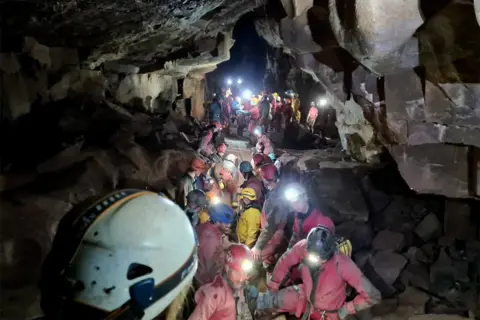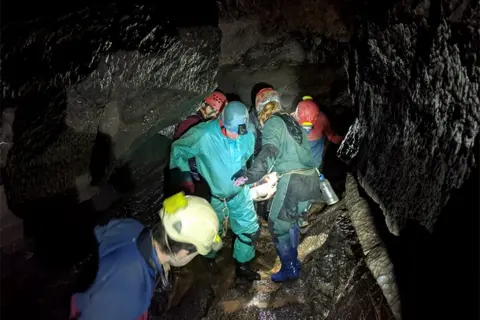The extraordinary story of how 300 volunteers rescued a stranded caver
 South and Mid Wales Cave Rescue Team
South and Mid Wales Cave Rescue TeamOne of the UK's longest cave rescue operations has ended safely after 300 volunteers came together from across the country to put their caving expertise to the test.

"I was lying in the passageway at one point, and to the right of me there was a Yorkshire accent. To the left there was a Somerset accent, and opposite me an Irish accent," says one rescuer - reflecting on the diversity of those who travelled to the Brecon Beacons for the critical mission.
Steve Thomas of the South and Mid Wales Cave Rescue Team is describing just one of the incredible moments in the 54-hour-long operation to bring an injured caver to safety.
There are 16 cave rescue teams across England, Wales and Scotland - and each one usually operates alone. But, "very occasionally you get a situation like this", says Mr Thomas.
"It's a question of all hands to the pump - all the other teams rally round to work on a mutual problem."
Ten teams came together, each travelling up to 200 miles, taking time off work, and spending more than two days crawling through the freezing water of the fearsome Ogof Ffynnon Ddu cave system - spurred on by banter and little treats stored in their helmets.

Ogof Ffynnon Ddu, which translates as Cave of the Black Spring, is not for novices - and permits are needed to visit it.
It is one of the deepest cave systems in the UK, with its lowest passageways 274m (901ft) below the surface.
According to the South Wales Caving Club, its size and very technical nature make it "challenging even for experienced cavers".
The entire route from the system's top to bottom entrances is described as a "classic" - during which cavers will see everything from "huge chambers, beautiful formations, to yawning chasms and thundering river passages".
 Brendan Marris
Brendan MarrisThe stranded man - who has been named as George Linnane from Bristol, and described as an "experienced, fit caver" - entered with his caving partner via the Cwm Dwr entrance on Saturday afternoon. They got about a mile into the 43.5-mile (70km) underground network when he fell and was unable to move.
It later transpired Mr Linnane had suffered tibia, fibula, jaw and chest injuries.
It was "an unfortunate, chance accident", says one rescuer, Peter Francis. "A matter of putting his foot in the wrong place".
Steve Thomas says accidents happen to even the most competent cavers. "A boulder can stay in place for 10,000 years and one day it will just move and that's just the way it goes."
The caving partner raised the alarm and Steve Thomas's team quickly found him. He was assessed medically and his injuries were found to be serious but not life-threatening.
But the challenge facing cave teams was how to bring him out safely - through the underground system's labyrinthine passages. Jobs were allocated to rescuers - such as getting medical supplies and specialist equipment down to him.
A UK-wide call for help was then issued. South Gloucestershire Cave Rescue Group was first to join the efforts, but then the number of rescue teams converging on south Wales snowballed.
 PA Media
PA Media"This was a completely voluntary operation, nobody gets paid... and the co-operation between the teams and the standard to which everybody worked was absolutely 100%," says Mr Thomas.
The underground scene was "a real tangle of passages on multiple levels" says Bill Whitehouse of the Derbyshire Cave Rescue Organisation.
"Moving through a section of passage for an uninjured, fit caver can be a challenge - squeezing through things, climbing on things, wading through water and so on - but it can be done.
"But when people are immobilised they have to be put on a stretcher and brought out by a team of 10 or so people.
"Imagine everyone trying to manoeuvre the stretcher through holes only big enough for one person to go through. It's a very slow process - 10 to 20 times longer than normal."
Steve Thomas agrees. There were plenty of natural obstacles to navigate, he says.
"Caves are natural things, they have no footpaths. They are geological wonders but full of boulders, potholes and waterfalls. Each one has to be negotiated in its own way."
By about 04:00 on Sunday they had managed to get the man to a bigger passage and the operation was becoming technically easier, but Mr Thomas says the conditions still made for exhausting work.


"It can be tough, especially when there's a delay and you've got to wait. We were all soaked through to the skin and there's always a draught in caves so there's a chill factor and it doesn't take long to sap you."
Keeping team spirits up was crucial, he says, and "banter" played an important role.
"Just supporting each other. It's a very friendly environment that we create."
They also all carried sweets and chocolate in their helmets.
But conditions were brutal nevertheless. An electrically-heated "over suit", which the rescuers had carried down for Mr Linnane, ended up being used by a volunteer who was communicating with the surface and was getting cold.
Communication between the rescuers and those above ground was possible through a system called "Cave Link" which allows messages to be transmitted through rock via the water particles in the limestone - a system rescue leader Paul Taylor described as "absolutely revolutionary in this incident".
 South and Mid Wales Cave Rescue Team/PA Media
South and Mid Wales Cave Rescue Team/PA MediaBy Monday morning, more than 36 hours after Mr Linnane became trapped, Julian Carter - who works for National Museum Wales - was joking how they "should all be in work now". He spent two shifts co-ordinating efforts in the caves.
Meanwhile in Maesteg, north of Bridgend, the involvement of employees at architecture firm Thomas and Associates meant the company could not even open on Monday morning.
"We will be away today, we are assisting with a cave rescue in Powys. Let's bring him home. Have a great day, we will be back tomorrow," it posted.
Travelling hundreds of miles across the UK is a relatively short distance, however, compared with flying to Thailand to help with a rescue there. That is what some involved in the operation did in 2018, after 12 young footballers and their coach had become trapped deep inside a cave underneath a mountain in Chiang Rai province.
On that occasion it took two weeks to free them all.
In the Brecon Beacons - as in Thailand - complicated rescue attempts rely on trust and teamwork. They can't be done with just a handful of people.
Allan Berry, chairman of Derbyshire Cave Rescue, led a team of 18 to the Brecon Beacons. "It's a 3D maze down there," he says - with teams having to swap regularly because of the sheer physical effort. The distance in a straight line may not be huge, but the terrain is extremely difficult.
 South and Mid Wales Cave Rescue Team
South and Mid Wales Cave Rescue Team"Through squeezes and up waterfalls - and sometimes you have to bring the stretcher up vertically using ropes. Sometimes you are lying down and letting the stretcher slide over you or using your knees to let the stretcher go across."
By midday on Monday, the injured man was being moved towards the entrance and was talking to his rescuers.
It was, by now, the longest cave rescue ever undertaken in Wales according to those leading it, eclipsing the previous record that ran to 41 hours.
Some were predicting it could take another 10 hours to get him out, with one saying: "He's lucky to be with us. He's in a bad way."
However, by 16:30, with the drizzly and misty conditions turning to dark, rescuer Peter Francis sounded more optimistic.
"It's a matter of time before we get him out. He's warm, he's stable. The doctor with him is monitoring him the whole time and we're not worried about him getting hypothermia."
Rescuers had been attempting to keep the man fed and warm as well as dealing with basics, such as removing bodily fluids, as they neared the surface.
 Rex Features
Rex FeaturesRescuers had been unable to get him out of the Cwm Dwr entrance on a stretcher, so the operation involved getting him up to another one of the three exits, delaying the process.
By Monday evening, 70 volunteers were underground, in addition to specialist medics, before Mr Linnane was finally brought up at about 20:00.
Foggy and wet conditions in the Brecon Beacons meant an air ambulance helicopter was unable to land, and he was taken to hospital by Land Rover.
While rescuers described him as doing "remarkably well", equally remarkable was how cavers from around the UK pulled together in their community's hour of need.
"People were making food for the rescuers, organising teams to work in relay, calling up other volunteers, providing babysitting for those who brought their kids to the club because they were needed to help, but had no babysitter," said Marieke Vink, who praised the rescuers.
"From everywhere, volunteers arrived at the club, ready to put their own life on the line to rescue a fellow caver."

- SURVIVING HELMAND: Inspirational stories from those deeply affected by the conflict in Afghanistan
- TIP NUMBER 7: The families of Aberfan fight for justice

